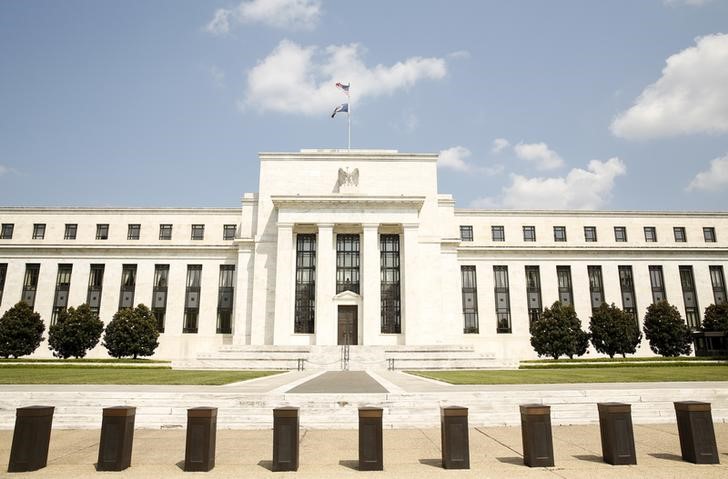By Sujata Rao
LONDON (Reuters) - Sometime this year, possibly even this week, the U.S. Federal Reserve will add billions of dollars to the annual cost of borrowing. Many firms, especially in emerging markets, seem ill-prepared for the inevitable.
Whenever the Fed finally starts tightening monetary policy, the impact will probably be felt for years by companies and households that loaded up on cheap debt during almost seven years of near-zero official U.S. interest rates.
The Fed lifted the U.S. economy from near-collapse in 2008 when it slashed the Fed funds rate, effectively the base rate underpinning borrowing costs around the world.
Now the heady years of rock-bottom rates are drawing to a close, with the Fed widely expected to raise them before the year-end and perhaps when its board meets on Thursday.
Memories are therefore stirring of the ruckus that followed past Fed tightening cycles - hedge funds collapses, emerging currency crises and debt defaults.
Some firms have anticipated the era of higher rates - which the U.S. central bank itself has been warning of for months - with steps such as cutting capital expenditure (capex). But this will do little to reduce a collective debt burden which has rocketed for years even though, by the laws of economics, the Fed was bound to reverse its policy sooner or later.
Brazilian oil firm Petrobras
Debt - to fund investment, expansion or just consumption - has ballooned almost everywhere, the Bank for International Settlements warned this week.
Dollar borrowing by non-U.S. entities had risen by 50 percent since 2008 to a record $9.6 trillion, it noted. Developing economies accounted for $3 trillion of this, double 2008 levels.
A separate report from consultancy McKinsey earlier this year calculated a $57 trillion increase in total global debt since 2007, a rise of 17 percentage points in the ratio of debt to annual economic output.
DIMENSION OF STRESS
Now it's payback time.
At Petrobras, every percentage point rise in borrowing costs will cut its net income by 15 percent, JPMorgan (NYSE:JPM) calculates, and the company itself expects annual debt repayments to more than double by 2019.
Relatively few borrowers have anticipated the higher rates by "delivering", or reducing their debts.
"Since 2008, the U.S. private sector is the only one that really delivered and almost everywhere else, there was a very significant increase in debt. Now we will see the overhang," said Salman Ahmed, global fixed income strategist at Lombard Odier in London.
He noted that the Fed action and all the related stresses will hit just as world markets are being destabilised by fears of a Chinese financial crisis. China has seen among the biggest rises in debt since 2008, and doubts are growing over its ability to manage this burden.
Together, the Fed and China factors have encouraged investors to withdraw huge sums from emerging markets. This is especially the case for emerging equity funds which have shed $58 billion year-to-date, according to Bank of America/Merrill Lynch, while equity funds in general have lost over $7 billion.
The dollar, rising in anticipation of higher U.S. rates, has jumped 10-30 percent against emerging market currencies this year.
"(The Fed) will add another dimension of stress to an already difficult situation," said Hung Tran, managing director of the Institute of International Finance, an industry body.
While a Fed delay until December may provide relief, Tran predicts that rate expectations will continue to strengthen the dollar, further boosting debt servicing costs for borrowers whose income is in other currencies.
All this perpetuates a vicious circle, with slower growth and costlier debt hurting company earnings in the coming years.
The ripples are already spreading. With about 30 percent of euro zone company revenues estimated to be linked to emerging markets and China, firms from Glencore (LONDON:GLEN) to Lonmin (LONDON:LMI) have scrapped dividends, promised to sell assets and lay off workers.
"In the short term after a Fed rate hike you are likely to see companies holding back or delaying any capex or capacity expansion that they might have planned for emerging markets," said Neil Wilkinson, portfolio manager at Royal London Asset Management.
"LET'S GET IT OVER WITH"
Worried by the slowing Chinese economy and sub-par global growth, organisations such as the World Bank have urged the Fed to hold fire. Surprisingly though, many central bankers from emerging economies are arguing that a U.S. rate rise will draw a line under the debt party and force governments into economic reforms they neglected when borrowing was easy.
It may also remove an uncertainty dogging their markets.
"The recent market selloff ... has made many investors feel that emerging market valuations are now less vulnerable to a Fed liftoff," JPMorgan said in a note headlined: "Fed - let's get it over with".
Borrowers also hope that if the Fed nips inflationary pressures early, it will prevent a sharp rise in longer-term, five- and 10-year U.S debt yields which are the main reference point for most emerging bonds.
Companies in emerging markets have had ample time to prepare for the Fed. Petrobras has slashed spending plans and others such as Indonesian state utility PT Perusahaan Listrik Negara say they may review their capital expenditure.
Another example is Malaysian mobile operator Axiata which plans to restructure a $590 million loan into an Indonesian rupiah-denominated Islamic bond to reduce its dollar exposure.
Finally, some are betting the Fed's hands will be tied by developments in China, the fear of provoking an emerging market crisis and most importantly, the risk of a rampant dollar derailing the U.S. recovery.
That may be why, with the Fed meeting two days away, investors' eyes are trained elsewhere. More than 40 percent of 716 global funds polled by Barclays (LONDON:BARC) picked China and the developing world as the biggest risk to world markets. Only 10 percent named the Fed.
